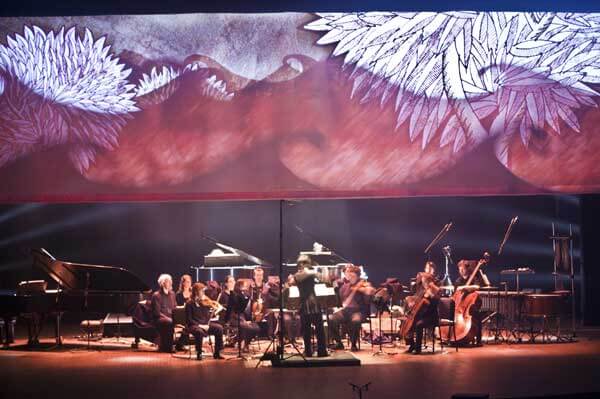![]() Every two years, Ensemble contemporain de Montréal (ECM+) provides four up-and-coming Canadian composers with a fantastic commission opportunity through its Generation Project. The project not only offers young composers a professional platform for performance of a new work, but also encourages creativity and innovation through a 90-minute workshop with ECM+. This year, ECM+ toured eight Canadian cities with works by Generation 2012 composers Annesley Black, Gabriel Dharmoo, Marielle Groven and Riho Esko Maimets. On November 12, 2012, the tour stopped at Von Kuster Hall on the campus of Western University in London, Ontario, for a performance and discussion of each of the works.
Every two years, Ensemble contemporain de Montréal (ECM+) provides four up-and-coming Canadian composers with a fantastic commission opportunity through its Generation Project. The project not only offers young composers a professional platform for performance of a new work, but also encourages creativity and innovation through a 90-minute workshop with ECM+. This year, ECM+ toured eight Canadian cities with works by Generation 2012 composers Annesley Black, Gabriel Dharmoo, Marielle Groven and Riho Esko Maimets. On November 12, 2012, the tour stopped at Von Kuster Hall on the campus of Western University in London, Ontario, for a performance and discussion of each of the works.

The program opened with Marielle Groven’s piece Animaris Currens Ventosa, which drew inspiration from a group of dynamic beast-like sculptures by Theo Jansen called Strandbeests. During her pre-performance discussion, Groven explained that she wanted to portray the pulses that these creatures might create. It began with soft string harmonics that moved in several patterns, immediately displaying a careful consideration of the possibilities that pulse provides. This string timbre remained an important element of the texture throughout, while the woodwinds provided a sonic landscape through sustained tones, and percussion and piano performed a more literal idea of pulse. Groven’s strongest asset was her command of the string ensemble; the sounds she achieved through meticulous notation of bowings were downright beautiful.
Next on the program was Gabriel Dharmoo’s Ninaivanjali. Where Dharmoo shines brightest is his melodic writing. It is both beautifully expressive and demonstrative of his time spent studying music in Chennai, India. An instrumental addition that displayed his multicultural roots was the tamburo drum, which was included seamlessly into the orchestration, but still contributed a musical timbre that was recognizably foreign. Of the four works on the concert, it seemed clear that the ensemble enjoyed playing Ninaivanjali the most–and with good reason. What Dharmoo brings to the table is not a melting pot of cultural influence, but a homogeneous, individual voice that demonstrates each of those influences and their expressive possibilities.
Riho Esko Maimets’s Beatitude for solo violin and ensemble was inspired by Matthew 5:5: “Blessed are they who mourn, for they shall be comforted.” During his pre-performance discussion, Maimets said that he had an affinity for vocal music, which he attempted to apply to his instrumental compositions. A long, slow, process-driven opening prepared a lyrical melodic line for soloist Véronique Mathieu that ascended through the entire range of the violin. Minimalistic repetition and process organized much of the music, as the ensemble’s string players repeated many of the virtuosic passages that were introduced by Mathieu (who made her difficult part seem run-of-the-mill). Maimets’s work was generally effective aside from one feature: a contrasting section in strictly baroque style. The audience was warned of this play on time during the pre-performance talk, but Maimets’s intention did not rectify the section’s artificiality.

The final work on the concert was Jenny’s last rock by Annesley Black, which was a musical depiction of the sport of curling (what else, the concert took place in Canada after all). Many of the performers had cassette players on stage with them that had prerecorded sounds including interviews with curlers and field recordings of curling tournaments. The ensemble members alternated between playing these tapes and performing instrumental transcriptions of the sounds on the tapes in what was without a doubt the most unique work performed on the concert. While this composition was unarguably adventurous, it lacked cohesiveness, due in part to the inherent difficulty in transcribing such peculiar sounds to a chamber ensemble.
A ballot was included in the concert program, and audience members was asked to vote for their favorite piece. (There was no shortage of jokes about how this might have gone over at a performance in Florida.) After all eight performances on the tour are completed, the votes will be counted and the winner of the “Audience Choice Award” will receive a $1,500 commission. The next Generation project is now seeking Canadian applicants under the age of 35. Entry guidelines are posted on the ECM+ website.
The eclectic nature of this performance allowed ECM+ to demonstrate its breadth as an ensemble, and they did just that. This is a wonderful group of musicians, and their contributions to these composers’ careers is more than admirable. They have several CDs available, each focusing on contemporary Canadian composers. I have not had a chance to listen to each of them yet, but what I have heard is fantastic, and definitely worth checking out.
–
Justin Rito is a composer, pianist, runner, Detroit Tigers fan, and microbrew lover currently living in London, Ontario.
























